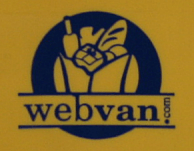Webvan
 | |
| Industry | Online retailer |
|---|---|
| Fate | Bankrupt, resurrected by Amazon.com in 2009 |
| Founded | 1999 |
| Defunct | 2001 |
| Headquarters | Foster City, California |

Webvan was an online "credit and delivery" grocery business that went bankrupt in 2001. It was headquartered in Foster City, California, USA, near Silicon Valley. It delivered products to customers' homes within a 30-minute window of their choosing.[citation needed] At its peak, it offered service in ten US markets: San Francisco Bay Area, Dallas, San Diego, Los Angeles, Chicago, Seattle, Portland, Atlanta, Sacramento, and Orange County. The company had hoped to expand to 26 cities.[citation needed]
In June 2008, CNET named Webvan the largest dot-com flop in history, placing it above Pets.com and eight other sites on its list.[1] It is now owned and operated by Amazon.com.
History

Webvan was founded in the heyday of the dot-com bubble in the late 1990s by Louis Borders, who also co-founded the Borders bookstore in 1971. Webvan's original investors included Benchmark Capital, Sequoia Capital, Softbank Capital, Goldman Sachs, and Yahoo!, who encouraged it to rapidly build its own infrastructure (the first-mover advantage strategy popularized by Amazon.com) to deliver groceries in a number of cities.[2] Some journalists and analysts blamed this serious error of judgment on the fact that none of Webvan's senior executives (or major investors) had any management experience in the supermarket industry, including its CEO George Shaheen who had resigned as head of Andersen Consulting (now Accenture), a management consulting firm, to join the venture.
Webvan tried to embrace a total customer satisfaction model involving a 30-minute window delivery without considering[citation needed] that many working customers would like their groceries delivered at home and at night.[citation needed]
HomeGrocer, a similar company, started operating the year before Webvan. It went public in March 2000 and, like Webvan, was losing large amounts of money.[citation needed] On 26 June 2000, Webvan bought out HomeGrocer.[3][4]
Bankruptcy

While Webvan was popular, the money spent on infrastructure far exceeded sales growth, and the company eventually ran out of cash. Webvan placed a $1 billion (USD) order with engineering company Bechtel to build its warehouses, and bought a fleet of delivery trucks[5]
As part of its shutdown process, all non-perishable food was donated to local food banks. Webvan's legacy consists of thousands of colored plastic shipping bins, now used for household storage[6] and their re-painted distinctly-shaped vans seen in the San Francisco area years later.
Similar businesses
The online grocery market sector in North America has seen many other failures, including Publix Direct. However, there have been a few successes. Two companies founded around the same time as Webvan that still exist today are Peapod started in 1989 in Chicago and SimonDelivers in the Minneapolis-St. Paul region of Minnesota and Wisconsin (although SimonDelivers shut down in 2008, it was acquired and re-opened as CobornsDelivers within months). Gopher Grocery is another online grocer in the Minneapolis-St. Paul area that has seen steady growth and success through its use of a just-in-time business model. The Greater Toronto Area is serviced by Toronto's original home and office delivery company Mr Case which was founded in 1984 and by Grocery Gateway, which has partnered with and is now owned by local grocer Longo's. The New York City market is increasingly served by FreshDirect, YourGrocer.Com and ShopRite from Home. Some other companies, such as Peapod in the Northeastern United States, and Winder Farms in the Western United States existed before the Internet became popular, and adapted their business models to the new medium. Grocer HyVee of the midwest offers a delivery service, sometimes with online ordering, depending on the location / service area.
A number of grocery chain stores also started offering online ordering and home delivery (for example, Safeway).
Amazon has also recently unveiled "AmazonFresh", an online grocery delivery service serving Seattle, Washington and Los Angeles, California. As of January, 2009, Webvan.com is operating as "part of the Amazon.com family" (i.e. shipping non-perishable items by UPS or other standard shippers, the way Amazon.com purchases are handled), offering "more than 45,000 non-perishable grocery items."[7]
In the UK, Ocado launched as a concept shortly after webvan in 2000, and started operations in 2002 following a very similar business model, but without giving credit. It subsequently listed in 2010 and reached a market capitalisation of GBP 2.5bn (~USD 4bn) as of Q4 2013. Ocado has been profitable at the operating level since 2011, showing the business model may indeed be viable if expansion is kept in check.
See also
- AmazonFresh
- Dot-com bubble
- e-commerce
- Grocery Gateway
- Irrational exuberance
- Ocado
- Peapod
- SimonDelivers
- Stock market bubble
- Winder Farms
- RelayFoods.com
References
- ↑ "The greatest defunct Web sites and dotcom disasters". CNET. 2008-06-05. Archived from the original on 2008-06-07. Retrieved 2011-02-10.
- ↑ Finkelstein, Sydney; Harvey, Charles & Lawton, Thomas (2007). Breakout Strategy: Meeting the Challenge of Double-digit Growth. McGraw-Hill. p. 200. ISBN 0-07-145231-1.
- ↑ Webvan bags HomeGrocer for $1.2 billion
- ↑ HomeGrocer-Webvan: A timeline
- ↑ Wolverton, Troy (2001-10-30). "Seeking relics amid Webvan's ruins". CNET News.com. Retrieved 2007-04-30.
- ↑ Aboujaoude, Elias (2012). Virtually You: The Dangerous Powers of the E-Personality. W. W. Norton & Company. p. 54. ISBN 0393340546.
- ↑ "Webvan - Baking Supplies, Beverages, Breakfast Foods...& more". 2009-01-19. Retrieved 2009-01-19.